Abstract
In this paper, a new power control technique based on clipped error distribution is proposed for portable ultrasound imaging displays. To reduce the display power consumption, the backlight dimming is used to select the optimal point between the power reduction of a backlight and the high image quality. In this case, the clipped error, i.e., the saturation error for pixels exceeding the maximum expressible gray level, should be considered. Conventional algorithms do not consider the clipped error distribution, which is the spatial distribution of pixels with the clipped error in a frame image when the power consumption is reduced. Therefore, it degrades the image quality in the medical display. On the other hand, the proposed algorithm calculates statistical values for clipped error distribution by analyzing the image characteristics. Hence, it can avoid degradation of the image quality by concentrating the pixels with clipped errors in a small region. In addition, the proposed algorithm uses a sampling technique, which only uses selected pixels based on the pre-defined sampling pattern, to reduce the computation time. Experimental results show that the proposed algorithm can improve the image quality in terms of peak signal-to-noise ratio by up to 7.063 dB (23.49%) while reducing the computation time by up to 0.451 μs (17.18%) using a sampling technique.
1. Introduction
Recently, several portable ultrasound imaging devices have been developed because of the importance for mobility and cost-effectiveness [1,2,3]. Portable ultrasound imaging devices operate on a battery-based power system. Therefore, efficient power management should be considered in order to increase the operation time, especially when the portable device consists of a liquid crystal display (LCD). Therefore, reduction of display power consumption is crucial. Typically, LCD devices consist of a liquid crystal module, which controls the intensity of the light, and a backlight module, which emits the light. Backlight dimming is one of the most efficient techniques to reduce power consumption in an LCD structure. Specifically, it reduces the backlight brightness in a backlight module while increasing the gray levels of the pixels in a liquid crystal module so as to maintain the brightness of an original image.
The purpose of the backlight dimming is to select the optimal point between the power reduction of a display backlight and the high image quality, and it generally involves three stages: image analysis, backlight modulation, and image compensation. In the first stage, an image characteristic is analyzed to decide the dimming rate of the brightness, which is the rate of the decreased brightness to the original brightness in a backlight. In the second stage, the brightness in the backlight module is reduced on the basis of the brightness dimming rate. In the third stage, the decreased brightness is compensated for by increasing the gray levels of pixels in the liquid crystal module. However, the dimmed backlight brightness can be restored only under the compensation limit. The compensation limit is the highest gray level that can restore the reduced brightness to the original brightness when increasing gray levels of pixels in order to improve the light penetration. Therefore, if the dimming rate exceeds the compensation limit, some pixels incur a clipped error where gray levels of pixels are saturated, thereby not describing higher gray levels over the compensation limit. Figure 1 shows the gray-level mapping between input and output signals in the backlight dimming. When the backlight brightness is decreased, the image compensation increases gray levels under the clipped point (gC), which is an initial gray level of the clipped error, like a red line to increase the brightness. However, gray levels higher than gC are saturated into the clipped point, and the clipped error occurs between the clipped point (gC) and the maximum gray level (gMAX) in an input frame. This error may lead to false diagnoses of patients undergoing ultrasound imaging. However, if the error is negligible and perceptually allowable (i.e., an allowable error), it is permitted so as to facilitate further reduction in power consumption.
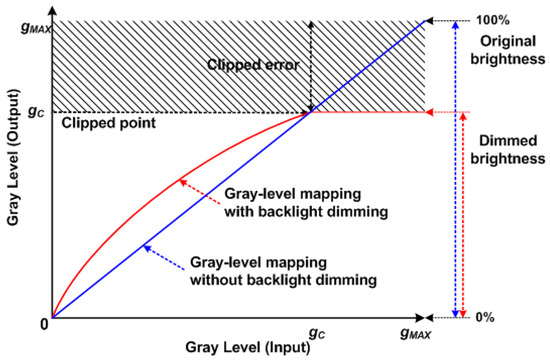
Figure 1.
Gray-level mapping between input and output signals in the backlight dimming.
Several methods have been proposed for controlling the clipped error [4,5,6,7]. Dynamic backlight luminance scaling [4] dynamically dims the backlight brightness using a clipped rate, which is the ratio of the number of pixels with the clipped error to the total number of pixels in a frame, to compensate for the brightness. However, the clipped rate is fixed, which results in degradation of quality for some images. Contrast enhancement-based backlight scaling [5] decreases the backlight brightness to compensate for the brightness along with contrast enhancement to enhance the image quality. However, this method also uses a fixed clipped rate, and hence, it suffers from the same drawback as the former method. Histogram equalization-based backlight scaling [6] uses histogram equalization to improve the image quality in order to compensate for the degradation of the image quality due to dimming of the backlight brightness. However, it also uses a fixed clipped rate because of which it suffers from the same drawback as the previous method. Furthermore, the characteristics of an original image get distorted because of the use of histogram equalization. To dynamically control the clipped rate based on the image characteristics, image integrity-based gray level error control (I2GEC) [7] uses the peak signal-to-noise ratio (PSNR) as an objective metric to analyze an image. It calculates the final clipped error and clipped point in the histogram for a given input image considering the target PSNR. Specifically, it is a method to control the allowable error by calculating the exact error value for the image using PSNR. However, even if the PSNR is high, humans can detect a clipped error if the pixels with the clipped error are concentrated in a small area.
Structural similarity (SSIM) preservation-based backlight dimming [8] was proposed to solve this problem. It considered the perceptual SSIM metric, and then, selected the clipped point between the image quality and power reduction. Segmentation-based backlight dimming [9] was proposed to select the clipped point adaptively considering the image characteristics based on the image segmentation. To reduce the computational complexity, the fast segmentation-based backlight dimming [10] was also proposed. Recently, saliency map-based backlight dimming [11] was proposed to consider the visual attention for a given image. On the other hand, there were power control algorithms for organic light emitting diode displays. The power control algorithm using optimal mapping curve determination [12] was proposed considering the mapping relationship between input and output signals. In addition, perceptual quality-based power reduction [13] was proposed to reduce more power consumption.
This paper proposes a new power control algorithm that considers clipped error distribution for ultrasound imaging displays. The proposed algorithm is a variation of the I2GEC algorithm. However, I2GEC cannot be used by the image quality degradation generated by the concentration of pixels with the clipped error. On the other hand, the proposed algorithm can consider the pixel concentration and preserve perceptually the image quality compared to an original image while reducing the power consumption. Specifically, the proposed algorithm analyzes the image characteristics and calculates several statistical values for clipped error distribution. Hence, it can prevent degradation of the image quality, which is caused by the concentration of the pixels with clipped errors in a small region.
2. Proposed Method
2.1. Pre-processing Module
The proposed algorithm largely consists of two parts as shown in Figure 2: pre-processing module and main processing module. The operation of the proposed algorithm is described in detail below.
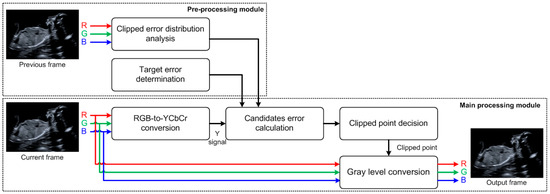
Figure 2.
Overall block diagram of the proposed algorithm.
The proposed algorithm calculates two components to select the optimal gray level between the power consumption and image quality: one is the clipped error distribution analysis, and the other is the target error determination. The target error is the maximum allowable error generated by the difference between gray levels of an original image and an image with the clipped error. First, the proposed algorithm requires the clipped error distribution of a total frame to calculate an optimal allowable error. To calculate the clipped error distribution, the proposed algorithm analyzes the distribution of input pixels and calculates several statistical values. In this case, for real-time processing, the proposed algorithm computes statistical values from a previous frame, and applies it to the processing of the current frame, because successive frames are significantly similar in images used in medical applications. Figure 3 shows the specific operations of clipped error distribution analysis. First, it converts RGB signals into YCbCr signals and selects the Y signal, where the luminance is a dominant signal in an image. Directional index arrangement is performed using the Y signal. Specifically, horizontal and vertical indexes (x and y) of pixels are extracted for all gray levels. In this case, they are arranged for each gray level using a sampling ratio (δ), which is a ratio of the number of sampled pixels to the number of all pixels, as follows:
where Nrow and Ncol denote the total number of horizontal and vertical indexes, respectively. Ni denotes the total number of indexes for i-th gray level. fn−1 denotes the previous frame. xs and ys denote horizontal and vertical indexes in the sampled frame, respectively (1 ≤ x ≤ Nrow and 1 ≤ y ≤ Ncol). i and k denotes gray levels within the range of 0 to 255 and the range of 1 to Ni, respectively. In this process, some pixels are sampled in an input frame to reduce the computational complexity by using a sampling ratio of 2, 4, and 9 as shown in Figure 4 (an experiment for changing the sampling ratio is described in the next section). The proposed algorithm generates positional histograms (Hx and Hy) for x and y axes to analyze the clipped error distribution for each gray level.
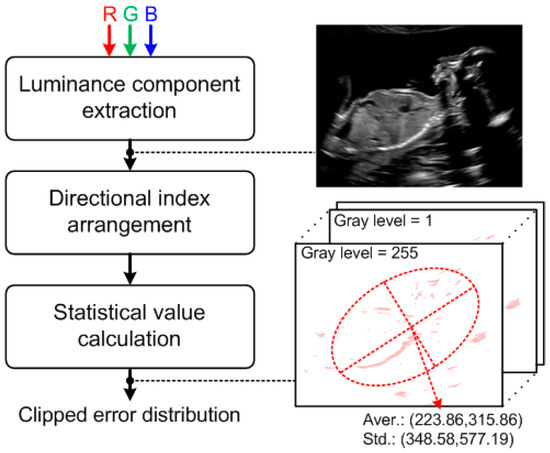
Figure 3.
Block diagram for analyzing the clipped error distribution.
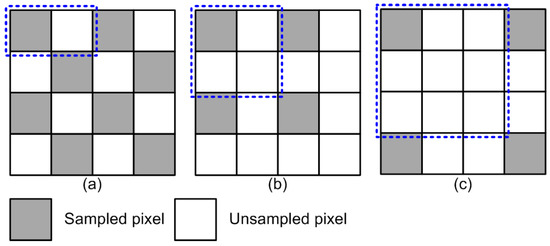
Figure 4.
Examples of sampling patterns for various sampling ratios: (a) 2, (b) 4, and (c) 9.
In the statistical value calculation, average values of horizontal and vertical indexes (Ax and Ay) are computed by using the positional histograms for each gray level as follows:
In addition, using the average values, standard deviations of horizontal and vertical indexes (Sx and Sy) are calculated as follows:
Second, an allowable error is determined by using the mean square error (MSE) and the PSNR similar to I2GEC [7]. They are defined as follows:
where Nrow and Ncol denote the total number of horizontal and vertical pixels, respectively. Ox,y denotes a gray level of the i-th pixel in the original image. Px,y denotes a gray level of the i-th pixel in an image with the clipped error that will be generated by the proposed algorithm. The proposed algorithm sets a target PSNR into a pre-defined value, and then, calculates an allowable MSE (MSEA) and an allowable target error (ERA) as follows:
2.2. Main Processing Module
2.2.1. Candidate Error Calculation
Using the clipped error distribution and the target error, the RGB-to-YCbCr conversion is performed and the Y signal is extracted when a current frame is inputted as shown in Figure 2. This is because the computational complexity can be reduced only if the Y signal is used instead of three RGB signals. Then, the candidate error is calculated considering ERA for the target image quality and the statistical values for clipped error distribution. To do this, a histogram for the Y signal is computed, and the highest gray level among all Y signals in an input frame is extracted. Then, the candidate error is calculated using the coefficients of horizontal and vertical variations (Cx(i) and Cy(i)) as follows:
where ERC denotes the candidate error, and HL(i) denotes the number of luminance signals with an i-th gray level. gMAX and gC denote the maximum gray level in Y values of an input frame and a gray level for the candidate clipped point, respectively, as shown in Figure 1.
2.2.2. Clipped Point Decision
The coefficients of variations are calculated to normalize the standard deviation because the standard deviation is significantly changeable depending on the image resolution. gC is started from gMAX − 1, and the candidate error (ERC) is compared with the allowable error (ERA) while decreasing by one gray level of gC following each trial. Specifically, if ERC is smaller than ERA, gC is decreased by one and ERC is recalculated. If ERC is larger than ERA, the previous gC is selected as the final clipped point. Next, the gray level conversion is performed by using the clipped point, as shown in Figure 2. For example, if the clipped point is 220, gray levels over 220 are changed to 220, which is perceptually allowable. Otherwise, the original gray levels are preserved.
3. Simulation Results
3.1. Simulation Environments
For the evaluation of the proposed algorithm, three fetal ultrasound image sets, which consist of 186, 238, and 43 frames, were used for the test sequences. Hence, the proposed and benchmark algorithms were evaluated on fetal images. The target PSNR was set to 30 dB in all test sequences. This is because the images with PSNR higher than 30 dB are acceptable [14,15]. The pixel resolution of all image sets was 1024 pixel × 768 pixel. The sampling ratio of the proposed algorithm for calculating clipped error distribution was changed from 2, which permits selection of a pixel among two pixels only, to 9, which permits selection of a pixel among nine pixels. The proposed algorithm was compared with a benchmark algorithm, which is the previously proposed I2GEC [7], in terms of image quality, power consumption, and the computation time. The computation times were measured by using MATLAB on a PC with an Intel® Core™ i3-2120 3.30 GHz processor. For measuring the power consumption, the backlight power is modelled as a function of the driving current [6]. To consider the saturation phenomenon of the backlight source, a two-piece linear function is used to characterize the power consumption [6], and the unit is Watt. Specifically, the power model of [6,7] using TFT-LCD LP064V1 [16], where the maximum power is 2.62 W, was used as follows:
where Cs and Qlin denote 0.8234 and 1.9600, respectively. Clin and Qsat denote -0.2372 and 6.9440, respectively. Csat denotes -4.3240.
3.2. Evaluations
Figure 5 and Figure 6 show the visual comparison of the image quality between the proposed and benchmark algorithms. The benchmark algorithm had significant clipped errors in regions where high gray levels were concentrated whereas the proposed algorithm reduced the error by considering the clipped error distribution as well as the objective image quality based on PSNR. Table 1 shows the average and minimum PSNRs for the proposed and benchmark algorithms. The proposed algorithm improved the average PSNR by up to 6.711 dB, compared with the benchmark algorithm, while maintaining the minimum PSNR higher than 36.266 dB. If the sampling ratio in the proposed algorithm increased from 2 (Proposed 2) to 9 (Proposed 9) for analyzing the clipped error distribution, the average PSNR was changed slightly. Table 2 shows the average power consumption and power reduction rate for the proposed and benchmark algorithms. The image quality and power consumption had a tradeoff relationship. Therefore, the proposed algorithm required more power than the benchmark algorithm. However, this drawback is effectively compensated for by the improved image quality, which is especially vital in medical applications. When increasing the sampling ratio in the proposed algorithm, the average power consumption was also slightly changed. Figure 7a,b show the graph comparison for the average PSNR and power consumption based on Table 1 and Table 2. In Figure 7, the standard deviations and minimum values of tables were removed, because they were too small to be seen in the graphs. In these graphs, the proposed algorithms with and without the sampling technique improved the average PSNR while requiring more power consumption.
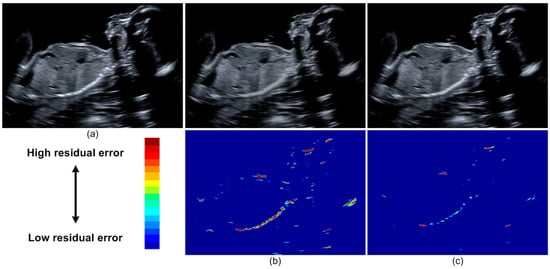
Figure 5.
Quality comparison for the 7th image of the 2nd ultrasound image set: (a) original image, (b) images generated by I2GEC (PSNR: 30.076 dB, Power: 0.931 W), and (c) images generated by the proposed algorithm (PSNR: 36.694 dB, Power: 1.261 W) (top: result image; bottom: difference between the original and processed images).
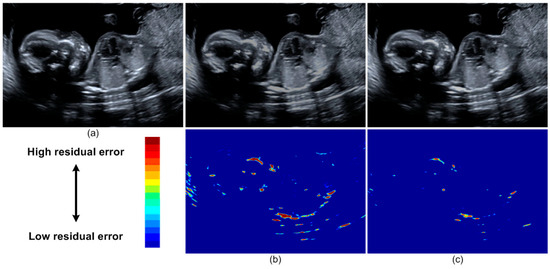
Figure 6.
Quality comparison for the 21st image of the 3rd ultrasound image set: (a) original image, (b) images generated by I2GEC (PSNR: 30.104 dB, Power: 0.931 W), and (c) images generated by the proposed algorithm (PSNR: 36.599 dB, Power: 1.253 W) (top: result image; bottom: difference between the original and processed images).

Table 1.
Average and minimum PSNRs for the proposed and benchmark methods.

Table 2.
Average power consumption and power reduction rate for the proposed and benchmark methods.

Figure 7.
Graph comparisons between the proposed and benchmark algorithms: (a) average PSNR, (b) average power consumption, and (c) average computation time.
Table 3 and Figure 7c show the average and minimum computation time per pixel and the graph comparison for the proposed and benchmark algorithms. The proposed algorithm using a sampling ratio of 2 required higher computation time by up to 0.365 μs, compared with the benchmark algorithm. However, when using a sampling ratio of 4 and 9, the proposed algorithm exhibited a reduction in the average computation time by up to 0.602 μs and 0.751 μs. Table 4 shows the comparison between the proposed and benchmark methods for the number of operations. ADD and MUL denote the addition and multiplication, respectively. In the simulation, Nrow, Ncol, and Nbit were 1024, 768, and 8. The sampling ratio was changed from 2 to 9. If the sampling ratio was 2, the proposed algorithm needed more additions. However, if it increased over 4, the operations of the proposed algorithm were lower than those of the benchmark algorithm. Therefore, the proposed algorithm can be implemented in real time [15].

Table 3.
Average and minimum computation times for the proposed and benchmark methods.

Table 4.
Comparison between the proposed and benchmark methods for the number of operations.
4. Conclusions and Discussion
This paper proposes the clipped error distribution-based power control algorithm for ultrasound imaging displays. The proposed algorithm analyzes the characteristics of an input image and computes several statistical values for clipped error distribution. Then, it selects the optimal power consumption considering the image quality and clipped error distribution, thereby enhancing the image quality when decreasing power consumption. In experimental results, the image quality of the proposed algorithm using PSNR was up to 7.063 dB higher than the benchmark algorithm, and reduced the computation time by up to 0.451 μs with a sampling technique.
In the proposed method, the power consumption can be adaptively reduced considering the optimum image quality of the display. However, in order to be used for medical use, it is necessary to consider the power consumption and image quality within a range that does not affect the diagnosis. Future work should consider this factor. In addition, we proposed a processor-based backlight dimming capable of real-time operation in [15]. In the proposed method, we can use the sampling technique to operate below the computational complexity of the I2GEC method, which is based on [9]. Considering this, we plan to develop the proposed method as a hardware system that can process in real time.
Author Contributions
S.I.C. and S.-J.K. conceived and designed the experiments; S.I.C. and S.-J.K. performed the experiments and analyzed the data; S.I.C. and S.-J.K. wrote the paper.
Funding
This research received no external funding.
Acknowledgments
This research was supported by the National Research Foundation of Korea (NRF) grant funded by the Korea government (MSIT) (No. 2018R1D1A1B07048421), and by the MSIT(Ministry of Science and ICT), Korea, under the ITRC(Information Technology Research Center) support program(IITP-2019-2018-0-01421) supervised by the IITP(Institute for Information & communications Technology Planning & Evaluation).
Conflicts of Interest
The authors declare no conflict of interest.
References
- Szabo, T.S. Diagnostic Ultrasound Imaging: Inside Out; Szabo, T.S., Ed.; Elsevier Academic Press: Burlington, MA, USA, 2004. [Google Scholar]
- Stergiopoulos, S. Advanced Signal Processing Handbook: Theory and Implementation for Radar, Sonar, and Medical Imaging Real Time Systems; Stergiopoulos, S., Ed.; CRC Press: Boca Raton, FL, USA, 2000. [Google Scholar]
- Karaman, M.; Li, P.C.; O’Donnell, M. Synthetic Aperture Imaging for Small Scale Systems. IEEE Trans. Ultrason. Ferroelectr. Freq. Control. 1995, 42, 429–442. [Google Scholar] [CrossRef]
- Chang, N.; Choi, I.; Shim, H. DLS: Dynamic Backlight Luminance Scaling of Liquid Crystal Display. IEEE Trans. Very Large Scale Integr. VLSI Syst. 2004, 12, 837–846. [Google Scholar] [CrossRef]
- Lai, C.C.; Tsai, C.C. Backlight power reduction and image contrast enhancement using adaptive dimming for global backlight applications. IEEE Trans. IEEE Trans. Consum. Electron. 2008, 54, 669–674. [Google Scholar] [CrossRef]
- Iranli, A.; Fatemi, H.; Pedram, M. HEBS: Histogram Equalization for Backlight Scaling. In Proceedings of the conference on Design, Automation and Test in Europe, Munich, Germany, 7–11 March 2005; IEEE Computer Society: Washington, DC, USA, 2005; pp. 346–351. [Google Scholar] [CrossRef]
- Kang, S.J.; Kim, Y.H. Image Integrity-based gray-level error control for low power liquid crystal displays. IEEE Trans. Consum. Electron. 2009, 55, 2401–2406. [Google Scholar] [CrossRef]
- Kang, S.J. SSIM Preservation-based Backlight Dimming. IEEE/OSA J. Disp. Technol. 2014, 10, 247–250. [Google Scholar] [CrossRef]
- Kang, S.J.; Kim, Y.H. Segmentation-based Clipped Error Control Algorithm for Global Backlight Dimming. IEEE/OSA J. Disp. Technol. 2014, 10, 568–573. [Google Scholar] [CrossRef]
- Kang, S.J.; Bae, S. Fast Segmentation-Based Backlight Dimming. IEEE/OSA J. Disp. Technol. 2015, 11, 399–402. [Google Scholar] [CrossRef]
- Ahn, Y.D.; Kang, S.J. Backlight Dimming based on Saliency Map acquired by Visual Attention Analysis. Displays 2017, 50, 70–77. [Google Scholar] [CrossRef]
- Kang, S.J. OLED Power Control Algorithm Using Optimal Mapping Curve Determination. IEEE/OSA J. Disp. Technol. 2016, 12, 1278–1282. [Google Scholar] [CrossRef]
- Kang, S.J. Perceptual Quality-aware Power Reduction Technique for Organic Light Emitting Diodes. IEEE/OSA J. Disp. Technol. 2016, 12, 519–525. [Google Scholar] [CrossRef]
- Kang, S.J. Processor-based Backlight Dimming Using Computation Reduction Technique. IEEE/OSA J. Disp. Technol. 2013, 9, 819–824. [Google Scholar] [CrossRef]
- Taubman, D.S.; Marcellin, M.W. JPEG2000 Image Compression Fundamentals, Standards and Practice; Taubman, D.S., Marcellin, M.W., Eds.; Kluwer Academic Publishers: Boston, NY, USA, 2002. [Google Scholar]
- LP064V1 Liquid Crystal Display. LG Display. May 2001. Available online: https://www.digchip.com/datasheets/parts/datasheet/1019/LP064V1.php (accessed on 9 April 2019).
© 2019 by the authors. Licensee MDPI, Basel, Switzerland. This article is an open access article distributed under the terms and conditions of the Creative Commons Attribution (CC BY) license (http://creativecommons.org/licenses/by/4.0/).